Channing Tatum and Jamie Foxx White House Down
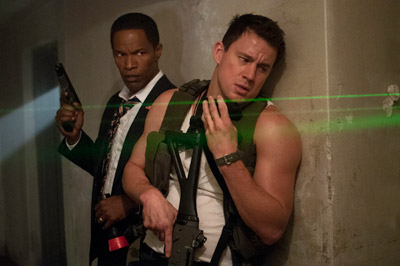
Channing Tatum and Jamie Foxx White House Down
Cast: Channing Tatum, Jamie Foxx, Maggie Gyllenhaal, James Woods, Richard Jenkins
Director: Roland Emmerich
Genre: Action; Drama; Thriller
Rated: M
Running Time: 131 minutes
Synopsis: In Columbia Pictures' White House Down, Capitol Policeman John Cale (Channing Tatum) has just been denied his dream job with the Secret Service of protecting President James Sawyer (Jamie Foxx). Not wanting to let down his little girl with the news, he takes her on a tour of the White House, when the complex is overtaken by a heavily armed paramilitary group. Now, with the nation's government falling into chaos and time running out, it's up to Cale to save the president, his daughter, and the country.
White House Down
Release Date: September 5th, 2013
About the Film
Columbia Pictures' White House Down is the new action film from director Roland Emmerich, whose films, including Independence Day, The Day After Tomorrow, 2012, and Anonymous, have taken in more than $3 billion worldwide. His latest film is an action movie on an epic scale starring the most recognisable home on the planet, which is very familiar territory for Roland Emmerich. 'Actually, that was the one thing holding me off – I wondered, -Can I really do the White House again?'" laughs the man who had aliens blow up the building in Independence Day and sent the aircraft carrier John F. Kennedy through it in 2012. 'Ultimately, I wanted to tell this story because it features strong characters and a very different and unusual narrative, combining action elements with those of a political thriller of worldwide significance."
'Obviously, Roland Emmerich likes to play with symbols and icons," says producer Bradley J. Fischer. 'If you look at the content of the films and the storytelling, his films are big event movies that unfold over a worldwide scale, but they're also about breaking down ivory towers of one form or another. So, sure, he's destroyed the White House before, but it's never been the centerpiece of the film – both in the plot and in the underlying storytelling – the way it is here."
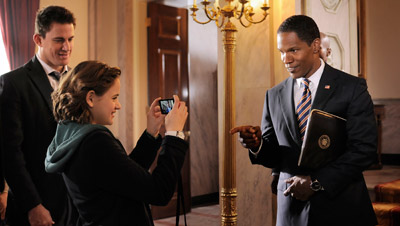 'This is really a global story," says producer Harald Kloser, who previously worked with Roland Emmerich as a writer and producer on 10,000 BC and 2012, and composed the music on those films as well as Anonymous and The Day After Tomorrow. 'If anybody takes over the White House, they'll have access to the world's largest weapons arsenal. A takeover of the White House would for sure trigger a global crisis with unimaginable consequences."
'This is really a global story," says producer Harald Kloser, who previously worked with Roland Emmerich as a writer and producer on 10,000 BC and 2012, and composed the music on those films as well as Anonymous and The Day After Tomorrow. 'If anybody takes over the White House, they'll have access to the world's largest weapons arsenal. A takeover of the White House would for sure trigger a global crisis with unimaginable consequences."
The character at the center of White House Down is John Cale, an ex-soldier and divorced father who's trying to put his life back on solid footing – especially when it concerns his relationship with his daughter. The role is played by Channing Tatum. 'Cale's been trying to figure out his life for years, to get it together. He doesn't really have the tools to put it all into place," says Channing Tatum. 'But his heart is good – he's always wanted to be his daughter's hero. And now that he's realising that he can't be that, due to mistakes he's made, he thinks, -Well, she idolises the president – if I can't be her hero, maybe I can help protect the guy who is.'"
'At the start of the movie, he's probably a better buddy than a father," says Channing Tatum. 'He's not a good role model or someone you want to go to for advice. But if the stuff hits the fan, he's the guy you want – he's been through a lot of it."
'That's part of the hero's journey in this movie," says Harald Kloser. 'He has to accomplish something on the outside – saving the world – and something on the inside. And the story on the inside is the emotional story with his daughter."
Opposite Channing Tatum, the filmmakers cast Jamie Foxx as President Sawyer. Bradley Fischer says that casting Jamie Foxx was part of the key to defining the tone of the film. 'We were hoping to find the right actor to play the President – somebody who could play it in a way that was a little disarming," says Bradley Fischer. 'We were hoping to find an actor who could bring the gravitas of the presidency, but also a comedic element – not jokes, but funny, light moments that would cut the tension. In a way, Cale and Sawyer are a classic -buddy' pairing. That's why Jamie Foxx was perfect – he won an Oscar® for the way he can inhabit different characters. Not only that, but it turned out he has great chemistry with Channing Tatum – they played off of each other in a way that we all found incredibly satisfying to watch. With Channing Tatum and Jamie Foxx together, the movie is just so much fun."
Jamie Foxx says that the 46th president of the United States is 'a man who would do anything to protect America, but also a man who understands that in order to protect America in this day and age, you have to have an understanding of the enemies. If you don't have that understanding, or a way to open a dialog, you'll forever be at odds and something drastic will constantly keep happening."
Roland Emmerich says that James Vanderbilt wrote the character of President Sawyer as an interesting counterpoint to Cale. 'When President Sawyer gets elected, he wants to do so much – and then when he's in the job, it's not that easy. He has to spend an inordinate amount of time on the politics of the job," says Roland Emmerich. 'Whereas Cale's goal is to try to impress himself and his daughter, the president is holding himself up against greatness – he wants to do something truly presidential, something Lincolnesque. He wants to be remembered as a great president. So that is part of the fun of the movie: you have a former soldier battling it out intellectually with the commander in chief as they're stuck together throughout the movie."
Bradley Fischer came to the project along with his Mythology Entertainment partners, James Vanderbilt and Laeta Kalogridis, when Vanderbilt revealed to Bradley Fischer that he had written the project in secret. 'James Vanderbilt said, -I've been working on something. I don't think it's quite ready yet, but I want you to take a look at it.' So I took a look at it and told him he was crazy, because it was fantastic. The script started making its way around town and before we knew it, we were getting unsolicited offers from studios. We decided to go with Sony, and within 48 hours, we were sitting with Roland Emmerich, the movie was greenlit, and we were off to the races."
'When I started this project, I was excited to try to bring back the type of action movie that I grew up with: the ordinary man in extraordinary circumstances having to rise to the occasion," says James Vanderbilt. 'Part of the excitement for me was the inherent mystery of the White House. It's ironic – here's the most famous, the most iconic building in the world, and yet it remains a place of great mystery for so many people. In that way, it was a perfect setting for an action thriller, because the building always brought that element of surprise."
James Vanderbilt says that Roland Emmerich was a perfect choice for director. 'The biggest thing we were able to do right off the bat was get Roland Emmerich," he says. 'He understands innately how to make this film big, explosive, huge – but also tight and contained, in one location. He focuses first and foremost on story, on the emotional connections between the characters. I think that's the secret to Roland Emmerich that nobody realises: he's a very emotional director. His stories are all rooted in emotion. If you look at Independence Day and The Day After Tomorrow, both of those movies are about people trying to reconnect with each other in the face of tragedy. So what was so great about watching him attack the movie was he was always asking, -What does Cale want?' And for Cale, everything is about getting back together with his daughter."
'When you work on a film with Roland Emmerich, 5% of the conversations are about the big images and 95% are about what drives the characters, who they are, details about where they come from, where they want to go, who they want to be," says Harald Kloser. He also notes that once filming begins, Roland Emmerich's filmmaking skills shine. 'I'm always impressed by how he composes his images and how much detail he puts in. When you see it on screen, you see the layers and the depth of his images – which is also a testament to our fabulous director of photography, Anna Foerster. This movie became an action movie with a beauty that I can say hasn't been done before."
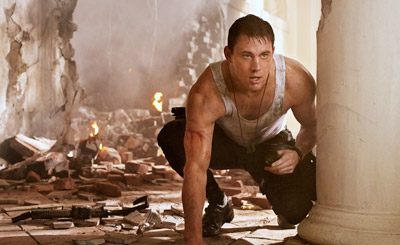 Part of that comes through in the depiction of the third key character in the film – the title role. To make White House Down, Roland Emmerich and his team committed to making the setting as realistic as possible. 'The White House is the star of the film," says the director. 'Working there, visiting there, is not like going to any other building in the world. A lot of countries have a presidential palace, but most of the time the president doesn't live there anymore, it's just a representative thing. America's such a unique country in that way – the White House is our house, the people's house, and the president lives in it."
Part of that comes through in the depiction of the third key character in the film – the title role. To make White House Down, Roland Emmerich and his team committed to making the setting as realistic as possible. 'The White House is the star of the film," says the director. 'Working there, visiting there, is not like going to any other building in the world. A lot of countries have a presidential palace, but most of the time the president doesn't live there anymore, it's just a representative thing. America's such a unique country in that way – the White House is our house, the people's house, and the president lives in it." 'With that in mind, we said, -Let's make this as real as we can,'" Roland Emmerich continues. 'We thought that would be the most fun way to do it, and it was a lot of fun to research. Naturally, we had to make educated guesses about a couple of things – there are parts of the White House that have never been photographed, and other parts that are rumours or hearsay – but it's pretty true to life."
To lend the film that level of accuracy and honesty, the filmmakers turned to McLarty Associates, where Richard Klein oversaw efforts as one of the film's White House Advisors. Founded by Thomas F. 'Mack" McLarty III, who served as President Clinton's chief of staff, McLarty Associates has built a global team of seasoned international specialists with expertise in all the major markets of the world; McLarty Media, their film and entertainment practice, advises major film studios, directors, producers and screenwriters on issues of international concern, covering story development, authentic script content, unique location requirements, and complex production logistics.
'Our firm is made up of former White House staff, senior aides to the president, Congressional staff, national security officials, and military officers – we all have lived and breathed and worked in the places that White House Down takes you," says Richard Klein. 'While the story itself might be fanciful, the world it's set in is very real and has a very real culture and very real set of rules. The filmmakers wanted to ground it in reality, because that would then make the storytelling a little more credible. Where they could base the movie in fact, they wanted to be factual. The goal was that when the movie comes out, the people who know this world will say, -They really knew their stuff,' and the people who don't know this world will say, -That was so cool!'"
Richard Klein says that on a project like White House Down, any number of questions might arise: What are the computer terminals like at the White House, and what do you see on the screen when you log in? What kind of buttons do members of Congress wear on their lapels so that security knows they're members of Congress? What does the military and the political dialogue sound like? What would the police do when a huge crowd descends on the White House – who would be in charge and how would that play out and what uniforms and vehicles would you see? What would the 24-hour watch at the Pentagon look like? When Channing Tatum picks up the Speaker of the House at the beginning of the movie, what kind of placard would he have on his car? What is the relationship between the Secret Service and the Capitol Police? All of these questions were answered by Richard Klein and his team. 'We spent weeks on the different identity badges that people in the White House wear and what that means in terms of access and movement and seniority, so we're accurate but cautious enough not to compromise actual White House security," Richard Klein says. 'There was an incredible eye for even the finest detail."
But the advisors also weighed in on a cultural reality as well as a physical one. 'We had input into the movie when it had to do with politics or tradition on Capitol Hill, or in the White House, or in the relationship between the Speaker of the House and the President," says Richard Klein. 'The realistic dialogue, the realistic social and professional interactions, the realistic sequencing of events – these are things that many of us worked with, and we had a receptive audience from the filmmakers."
About the Characters
At the center of White House Down is John Cale, played by Channing Tatum. Ex-military, now a Capitol policeman, Cale is a father struggling to bond with his estranged daughter. And as White House Down begins, it looks like Cale still hasn't quite figured it out. He's just been turned down by the Secret Service – despite his heroic career, he has been deemed unqualified to protect the president. But everything will change for him when that same day, on a chance visit to the White House, the unimaginable happens: a paramilitary group attacks the building, and only Cale is in a position to protect the president.
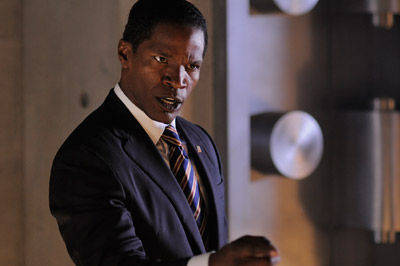 'It's the perfect motivation for the character," says producer Harald Kloser. 'He wants nothing more than to protect the president. And that's partly because his daughter wants that so badly, too – the president is her hero. But the person from the Secret Service who is doing the interview – the person who holds his future – doesn't feel he's up for the job. He doesn't get it. And then all hell breaks loose – he has to save his daughter, the president, and the world. He has to earn the job about 20 times throughout the course of the movie."
'It's the perfect motivation for the character," says producer Harald Kloser. 'He wants nothing more than to protect the president. And that's partly because his daughter wants that so badly, too – the president is her hero. But the person from the Secret Service who is doing the interview – the person who holds his future – doesn't feel he's up for the job. He doesn't get it. And then all hell breaks loose – he has to save his daughter, the president, and the world. He has to earn the job about 20 times throughout the course of the movie." 'The thing Cale really cares about is repairing his relationship with his daughter," says Channing Tatum. 'He's a guy who ran away from a lot of his problems, and even though he's stopped running now, he's wondering if it's too late. If it takes saving the leader of the free world to get the love and respect of his daughter, then that's just what he's going to have to do."
'Cale is a very ordinary guy," says Roland Emmerich. 'He's one of those characters who just wants to do the right thing, but whatever he does, it's not quite working. And then, with the events that happen in this story, he gets his chance. He has a very strong motivation, but a lot to overcome."
Part of the attraction to White House Down for Channing Tatum was the chance to work with Roland Emmerich. 'I've had so much fun on this movie," adds Channing Tatum. 'One morning we were shooting at five a.m. – it was a long day and he was the only one chipper as he could possibly be. He leads from the front, and I like that."
For Roland Emmerich, the feeling was mutual – the chance to work with Channing Tatum was the last piece of the puzzle that sealed the deal. 'When I met him, I immediately realised that I would only make the movie with him – if he didn't do it, I wouldn't, either," says the director. 'I realised he was exactly that character – a very good-looking guy, but with a strong -everyman' feeling about him. He's funny and smart, he knows what he wants."
'Channing Tatum has it all – he made perfect sense as John Cale," says Bradley Fischer. 'He's proven he's a movie star. When Roland Emmerich and Channing Tatum first met, Roland Emmerich said, -He's the guy. Without question.'"
Of course, Channing Tatum was perfect for the role not only for who he is – 'a guy who has an ease to him, a humour, confidence, even a little cockiness and swagger," as James Vanderbilt says – but how he is, physically. John Cale is a demanding action role, and Channing Tatum was up to the task, performing his own stunts when possible.
'Look, what would you rather see: an actor's face going through a window, or stuntman who turns his head at the last moment?" Channing Tatum says. Safety has to come first, of course, but Channing Tatum wants to do what he can. 'It doesn't hurt to go through the fake glass, it's one of those stunts that's safe for me to do, and it's fun to do it, so let's do it."
'On the set, there was a first time that we were going to do a stunt, when he said, -Well, I want to do this myself,'" Roland Emmerich remembers. 'I was surprised, but thinking about it, it makes sense. Look at his dance movies – Step Up, Magic Mike. Dancers are very good stunt people, because they have total control over their bodies."
Jamie Foxx as President James Sawyer is the man at the center of the storm in the film. 'It's a complicated role," says James Vanderbilt. 'You have to have a serious side as the President of the United States, but also, the president in our movie has got to be able to play the fun stuff as well. He's got to be able to play the physical stuff, the light moments, the dark moments, all of it. And on top of it all, the actor had to be believable as an electable president and pair well with Channing Tatum. Jamie Foxx was a perfect choice."
'In this situation, the President is faced with the beginning of a new world order," explains Jamie Foxx. 'He's learning that the might of the sword is not always the best course of action. We bring up some of these political issues, but not too heavy on the political side. It's a fresh look at what I would call a super action hero. Sit down, get ready for the ride, watch Channing Tatum go to work and do his thing as Officer John Cale."
Working with Roland Emmerich was a revelation for Jamie Foxx. 'As an actor who wants to be a director, I'd think about the movie and wonder, -Wow, the scope! How is he going to make this cinematic?' I got to watch him – I got the chance to look over his shoulder and get a peek at his shot list. It was really a blast. But Roland Emmerich was also a great collaborator – he allows you to bring in your own voice, your ideas, and then he shapes them in the way that he can execute the movie – and if you go too far off, he's there to pull you back in."
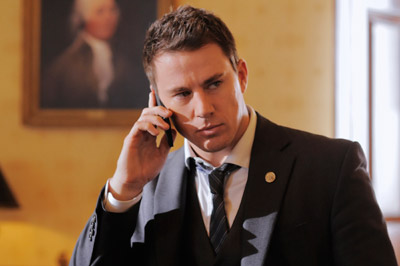 Helping John Cale and President Sawyer fend off the ruthless mercenaries and their quest to seize control of the White House is the exceptionally adroit, tough-as-nails Special Agent Carol Finnerty played by Maggie Gyllenhaal.
Helping John Cale and President Sawyer fend off the ruthless mercenaries and their quest to seize control of the White House is the exceptionally adroit, tough-as-nails Special Agent Carol Finnerty played by Maggie Gyllenhaal. At the beginning of the film, Carol Finnerty has just turned down Cale's application to join the Secret Service – but even that is not so simple. 'Years ago, they had a crazy love affair," says Maggie Gyllenhaal. 'It was a long, long time ago, but they were crazy about each other. And now he's back, she's interviewing him, and of course he's super-hot and amazing in a lot of ways. He still takes her breath away. But he's just not qualified to be a Secret Service agent."
Maggie Gyllenhaal says that her character's strength is knowing when to go by the book and when to toss it out. 'She's really good at her job, and to be excellent at any job, you have to follow protocol – but not at the expense of what is right or reasonable," she says. 'She very much believes in the system – that's why she turns down Cale. But when she sees people making decisions that are clearly wrong, she takes charge – and that means doing some unorthodox things. In that way, she's the voice of reason."
Jason Clarke joins the cast as the ex-soldier-turned-paramilitary-leader, the head of the invasion force, Emil Stenz. 'He's a former Special Forces guy – doing some nefarious things in strange places – and he became a gun for hire," says Jason Clarke. 'And now, he's been hired to try to take over the White House, to kidnap the president and try to make some money."
'The most impressive thing about this film, I have to say, is Roland Emmerich," says Jason Clarke. 'He wants to make the movie interesting and fun, but he also brings out the drama and gives the audience something to connect to. He's always got your back, he's always going to tell the story, and he really knows how to shoot."
Joey King joins the cast as Cale's daughter, Emily. Their estranged relationship is put to the test when they are separated during the crisis at the White House. 'At the beginning of the movie, her parents are divorced and she's not too keen on her dad," explains Joey King. 'That's why he takes her to his job interview with the Secret Service and gets her tickets to the White House tour – he knows she's obsessed with all things politics and he thinks that will impress her. And it does – she's super-excited. But then, when they get separated and all this crazy stuff happens, the whole movie is about their relationship. He's trying to get back to her, and she's realising how much he loves her and how much she loves him back."
Joey King relished the opportunity to work alongside Channing Tatum (and what girl wouldn't?). Naturally, playing father and daughter, the two were tight on set. 'We had this handshake, called the Chan shake. It's the coolest thing ever – it's the longest handshake in the world and we choreographed it ourselves," she says. 'He's so awesome and so fun… he's like my dad, brother, or best friend."
Richard Jenkins joins the cast as the Speaker of the House Eli Raphelson, a career politician from the opposing party, and James Woods as Martin Walker, the outgoing head of the Secret Service.
Designing The White House
The residence at 1600 Pennsylvania Avenue is not only the home and office of the President of the United States, but also an iconic symbol of democracy, leadership and freedom that draws 1.5 million visitors each year.
'When you're at the White House, the thing that really strikes you is that it isn't that big – it's just a house, surrounded by higher buildings and a park," says Roland Emmerich. 'On the other hand, they have every technology you can imagine and some you can't imagine, and there are all sorts of rumours about missiles on the executive building and the surrounding buildings. When you think about it, it's a huge security risk – and that's what our movie is about."
The task of designing and building the sets fell to production designer Kirk M. Petruccelli. 'Kirk Petruccelli is one of the unsung heroes of this production," says producer Bradley J. Fischer. 'He had one of the biggest challenges on this movie, to build these sets. We've only had glimpses of rooms we know exist – the Presidential Emergency Operations Center, or the beehive where the Secret Service works, which is actually below the Oval Office – so Kirk's job was to pull back the curtain a little bit and invite people behind the walls. He gave us a great playground to have as much fun as we could."
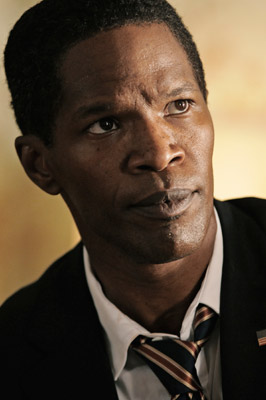 'My perception of the White House has always been that it's the center of our government, but what does that mean? What is this place?" asks Kirk Petruccelli. 'Of course, it's the iconic museum of our time, of American history, and through each administration."
'My perception of the White House has always been that it's the center of our government, but what does that mean? What is this place?" asks Kirk Petruccelli. 'Of course, it's the iconic museum of our time, of American history, and through each administration." Producer and screenwriter James Vanderbilt says, 'The great thing about the White House is the history behind it, and the rumours behind it, too. There's the history of the green room, where the body of young Willie Lincoln, President Lincoln's 11-year-old son, lay for the viewing, and his mother Mary Todd Lincoln would never go back into that room."
'Many things have happened, many things that no one knows if they truly exist – tunnels under the White House, for instance," says Kirk Petruccelli. 'Marilyn Monroe might have been down there, and we believe that it's possible. And I think between the history and secrecy, and all these other things lend to it being a great place to tell a story."
James Vanderbilt's approach to the screenplay began with research, but there's a point at which imagination has to take over. 'There are different levels of information on the White House," explains James Vanderbilt. 'There's a lot of stuff that's publicly available, and then, there's the level of stuff that nobody knows about. We contacted the White House, and in a lot of cases, they said, -We can't tell you that at all.' They couldn't confirm or deny the existence of the tunnels, the location of the Presidential Emergency Operations Center or any number of things."
When Kirk Petruccelli met with Roland Emmerich to discuss his objectives for the aesthetics of the film, they agreed that the set design for the film should be anchored in an attention to realism. 'Roland Emmerich's primary goal was to make an entertaining action-based drama and make sure that we were as close to reality as we could be," says Kirk Petruccelli. 'This was incredibly important and challenging, in that the White House is so well known that we had to get it right. It's one of the most photographed houses in the world and one of the most identifiable ones. It made my life easy in one way: we knew what it was. But it made it incredibly complicated in that it's so detailed and there's so much secrecy around it."
The process began with tours of the White House. 'It was really important for Roland Emmerich and me to go," recalls Kirk Petruccelli. 'By going to the White House, you learn a lot and your assumptions are proven wrong. The thing that stuck in my mind most was that it has two faces – there's a business face and a social face. The business face was going into the West Wing; you imagine a palatial place but, in essence, it's a very small, very business-oriented complex, and it's not over-designed. It's actually very succinct, very concise, and rather bureaucratic."
'And then there's the other face," continues Kirk Petruccelli. 'It's a glorious museum of history as you walk through the Great Hall right into the Green, Blue and Red Rooms, into the East Room, through the State Dining Room, and through the ground floor. There's the Secret Service, the Capitol police, hundreds, if not thousands, of tourists going through there – and yet, it's very peaceful, very respectful."
When the research was complete, Kirk Petruccelli assembled an army of 300 carpenters, 45 plasterers, 32 set designers, and 16 art directors to build the intricate sets. Their home became Mel's Cite du Cinema in Montreal, where the production took over all of the stages to re-create the White House. 'We reproduced the spirit of the White House as closely and as precisely as we could," explains Kirk Petruccelli. 'Architecturally, it was somewhat easier than it was with the décor. The architecture is a very classic structure. It has its different time frames: the original structure in 1792, the Jefferson colonnades, the Taft Oval Office, and so on. In 1952, Truman did a complete remodel of it, but kept the exterior walls intact. We wanted to make sure that we always included the organics, the idiosyncratic parts of the building, because it's a very old structure, and you see those things."
'The décor was a whole different matter," continues Kirk Petruccelli. 'We had teams scouring the world. We were in the United States, Canada, and Europe. We had carpets made in India. We had to build all of our light fixtures because, frankly, none of the stuff exists. They're so iconic that the only thing you can do is to do your best to reproduce them."
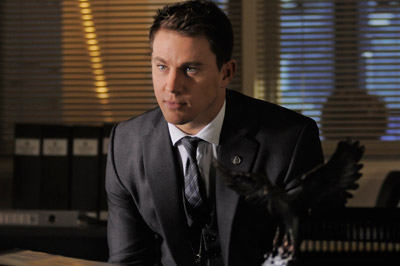 Not only that, but the logistics of the physical production made the set design a complicated matter. 'Because there are so many stunts, the Oval Office had to be created twice," notes Kirk Petruccelli. 'We had water, fire, and explosions happening in and around it. We worked closely with the practical effects team, so they knew where the bullets would hit, and we knew where to run cable inside the walls that were going to blow. The press corps offices, the Oval Office, the center hall, the Great Hall, the Great Staircase were all completely underwater. The Blue Room had a helicopter tail crash through it. The Green Room, the Lincoln Bedroom, the Master Bedroom were set on fire."
Not only that, but the logistics of the physical production made the set design a complicated matter. 'Because there are so many stunts, the Oval Office had to be created twice," notes Kirk Petruccelli. 'We had water, fire, and explosions happening in and around it. We worked closely with the practical effects team, so they knew where the bullets would hit, and we knew where to run cable inside the walls that were going to blow. The press corps offices, the Oval Office, the center hall, the Great Hall, the Great Staircase were all completely underwater. The Blue Room had a helicopter tail crash through it. The Green Room, the Lincoln Bedroom, the Master Bedroom were set on fire." But the interior of the White House was only part of the challenge. 'We also needed a set that would give us the enormity of the South Lawn and South Portico of the White House," says Kirk Petruccelli. 'It would have to be big enough that we could bring a tank in there, as well as our Marine One. No stage is big enough for that, so we started to look around. We tried to find an airport hangar, but none were available. And that's when we found -The Bubble' – an interior golf driving range. It has an enormous interior footprint and a sixty-foot-tall bubble on top. It functioned very well. We were able to build a lot of the scenery within it. It's one door in, one door out, a revolving door to keep the bubble up – and, when we were there, three-hundred-plus people inside, having a laugh."
Once the sets were completed, even the veterans were amazed by what had been accomplished. 'Throughout my work with Roland Emmerich, I have seen quite a few sets – even very big sets – but this one was notable," says producer Harald Kloser. 'At one point, I was walking through the set and I asked one of the production assistants where the bathroom was. I was expecting to be pointed down the hall, so I was surprised when she reminded me that our bathrooms were outside – I forgot I was on a set!"
Kirk Petruccelli and his team also worked closely with the visual effects team. 'The visual effects team and my team are connected at the hip from inception, and we depend on them and they depend on us to be collaborative and cooperative," explains Kirk Petruccelli. 'We are the first line up, but everything is built in the computer. So, what I have to do with my team is to make sure that it's tailor-made to what happens in post, because the visual effects teams have to then be able to function with it, and then extend it or manipulate it or recreate it or augment it."
'Every decision goes through a process, through Roland Emmerich first, through me, then to visual effects guys, and then through the visual effects guys back to me, because there's different things going on at different times," continues Kirk Petruccelli. 'On this film, we're planning the visual effects to be -invisible' – the kind that you don't realise you're watching visual effects – and if nobody realises that it's not real, then for me, that's the glory of it all."
Aside from the White House, Kirk Petruccelli's team was responsible for the Capitol hallways, the White House office suites, ancillary newsrooms, the streets throughout Washington, D.C., Air Force One, Marine One, the Pentagon Bunker, the Presidential Emergency Operation Center, the Secret Services offices, the South Lawn, the South Portico… and a little something called The Beast.
Building the Beast
It also fell to Kirk Petruccelli, along with Graham Kelly, the film's action vehicle supervisor, to recreate the presidential limousine, affectionately and accurately known as The Beast. This is no mere luxury production car: this is a rolling fortress.
'When I first took this job – to build three presidential limos – I thought, -Yeah, no problem,'" says Graham Kelly. 'I thought we'd just take a Cadillac limo and un-stretch it a bit. But then I saw a reference picture of a Secret Service agent standing on the back quarter of the car. He looked like a small guy. And then I realised… he probably wasn't a small guy. He was probably at least six feet tall. And that meant the car was enormous."
'The most surprising thing about this vehicle was the actual size of it," recalls Cyril O'Neil, president of Reel Industries, the company that built the cars. 'You look at photographs of the vehicle and you think it's a normal limousine. And we actually entertained the idea of actually building it on an existing limousine. But as you start to look at the dimensions, you start to figure out the actual size of it, and you start to realise that the car is a true anomaly. It's brilliantly designed in that it looks like a limousine, but it is not. On the outside, it is the size of a large truck, and on the inside, because of the armor that it has, it's the size of an SUV. The result was that everything on the vehicle had to be custom built – there was no starting with something and changing it. We would have to build the Beasts from the ground up."
One of the reasons it was so important to get it right was that Roland Emmerich was determined to shoot practically whenever possible. It seemed there was a never-ending list of tasks that the car would have to pull off. 'Every day, Roland Emmerich would tell me, -Oh, by the way, there's something else I want it to be able to do,'" and I'd just say, -Okay, Roland Emmerich.'"
For the production of White House Down, the filmmakers would need three replicas. And this was a tall order, because, in essence, nothing is known about the car. 'When we first took on the project, obviously the first place we went for information was the Secret Service," says Cyril O'Neil. 'We were told that as interesting as they found our project, they would be unable to provide us with information about the vehicle. They couldn't even provide us wheel base or length. They literally would give us no information about the vehicle."
Of course, some information was available through research. 'For many years, General Motors has been the company that has provided the vehicles for the Secret Service and provided the limousine for the President," says Cyril O'Neil. 'Cadillac has provided the presidential limo for decades. As far as I know, General Motors has been very intimately involved with the design of this vehicle. And it does carry very traditional Cadillac lines."
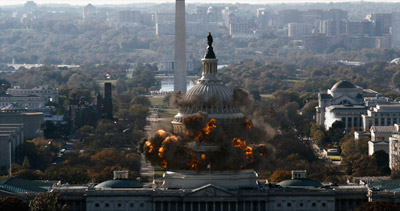 With that in mind, the way in to the design began with a bit of detective work. 'We made the assumption based on photographs that the headlight in the real Beast is a 2009 Cadillac Escalade headlight. That being the case, we took a 2009 Cadillac Escalade headlight and measured it. Knowing that dimension, we were then able to scale a photograph and determine all the other dimensions of the vehicle based on that."
With that in mind, the way in to the design began with a bit of detective work. 'We made the assumption based on photographs that the headlight in the real Beast is a 2009 Cadillac Escalade headlight. That being the case, we took a 2009 Cadillac Escalade headlight and measured it. Knowing that dimension, we were then able to scale a photograph and determine all the other dimensions of the vehicle based on that." 'Once we extrapolated the dimensions from the headlight and were able to put that out on a drawing, we handed those dimensions off to a small team of sculptors. Those sculptors actually took a block of foam that is roughly the size of the vehicle and hand sculpted the shape of this vehicle – everything you see – into that foam," explains Cyril O'Neil. 'Once the foam was done, we made a negative mould of the car, filled the negative mould with gel coat and fiberglass – and the body comes out as one piece. We put it onto a tube frame that we've built on a stretch Suburban chassis."
'The Beast is a good foot wider than most standard cars, and that's to accommodate the armour in the real car," says Graham Kelly. 'So we made ours to look that way. When you open the doors, you can see that we cast the car that deep."
To create the interior of The Beast, one single photograph served as the blueprint for their design. 'Nobody knows what the inside looks like," adds Cyril O'Neil. 'We took the interior design from a single picture that we have that shows an open door of the limousine. From that photograph, we were able to design, on our own, what we think the interior would look like, under the guidance of Kirk Petruccelli, the production designer."
Despite its size and heft, The Beast also had to be a marvel of speed and maneuverability. 'From the story requirements, the Beast had to crash through a wall, it had to have the ability to travel in an off road situation, be able to jump down off curbs, and be able to do sliding skids, potentially 180s or 360s as well," states Cyril O'Neil. 'That was a challenge, because in order to get the correct size of tire to give the car the right look, all the tires actually have to be truck tires on this car. Well, truck tires are very stiff and they are made to not flex at all, and that makes it a little bit more challenging to get the car to do a 180 or a 360. We knew we were going to have to give it ample power and speed to do the spins."
That power came from an LS1 Corvette motor. 'We had to make sure the engine was good," says Graham Kelly. 'That engine is about 420 horsepower, so it's man enough to handle all of the work it had to do."
About the Cinematography
The director of photography Anna J. Foerster, who previously worked with director Roland Emmerich on the period drama Anonymous, re-teamed with the director for White House Down. 'Anna Foerster doesn't want to be a cameraperson. Anna wants to be a director," says Roland Emmerich. 'So she approaches every shot like a director – everything is about the story."
'At first, it was difficult to talk Anna Foerster into doing the movie – -I'm not shooting an action movie,' she said. And I said, -Well, Anna Foerster, it will be the most beautiful action movie ever shot. What do you say to that?' She asked, -Can we go really radical?' -As radical as you want,' I said. And that's what we did."
'We decided to do the opposite of what people expect," says Anna Foerster. 'We're very extreme in the approach, contrasty sometimes, and at other times marginal, definitely not very conventional for the size of movie and for this genre, that's for sure."
Apparently, to a cinematographer, 'going really radical" means shooting with a very wide lens. 'It was something we started on Anonymous: we found that with the wide lenses, you can capture so much of the action as well as the whole scope," explains Anna Foerster. 'We have a favourite lens, a fifteen-and-a-half millimeter lens, which is really wide. It doesn't distort very much, so you don't have that feeling that you're looking through a fish eye – it just gives you this wide image so that you see rooms from window to door, which is great. The challenge is, it's very hard to light."
After all – if the lens is so wide that you're capturing the entire room, there's no place to hide the light. That's where the DP and director get clever. 'You have to be very careful how you plan certain scenes and certain shots so that you can position the cameras and the people in a way that it makes sense with the light that is coming from the window or from a practical light source," says Anna Foerster.
Roland Emmerich says that it's tricky, but worth it. 'All of these things add up to a very different-looking action film," he says.
Anna Foerster and Roland Emmerich also used blended light sources and reflections to avoid the perfect 'movie lighting" you might expect from an action movie, but Anna Foerster says it all serves the story. 'The imperfect lighting creates a real and immediate feeling," she says. 'If a character is standing in a dark corner and moves into the light, and now they're in silhouette, and in a moment they'll be overexposed when they stand next to a window – all of that creates a certain uneasiness, because we go with those people to those different places. It helps tell the story of a man who is, at various points, being chased or chasing somebody."
Executive producer Reid Carolin says, 'The way Anna Foerster has lit everything has blown me away. She's a true artist who plays with light and the set as if it's a painting. She creates incredibly sculpted, meticulous paintings with every frame."
About the Stunts
Overseeing the stunts and fight sequences in the film was stunt coordinator John Stoneham Jr. 'You always want the stunts to be a real thing and an art," explains John Stoneham. 'Our task on this show has been to keep the realism. Channing Tatum's got a really good eye for that – he would say, -Well, I wouldn't do that, this move doesn't make sense.' He had a lot of input in a lot of the fights, and he had a lot of great ideas."
Channing Tatum's expertise as a dancer and innate athletic ability made him a natural for stunt work. 'He has a certain skill level. It's his dancing background – I think gymnasts and dancers usually make good stunt people," says John Stoneham. 'They're just body-aware, and they know where they are in the air. He's quick-learning, he's fast, and action-wise, he makes it really easy for all of us. We can frame the camera so that we can see his face because we know he can do it. It's great for the film."
But it's more than just know-how with Channing Tatum. 'He's almost indestructible," says John Stoneham. 'He did take after take. He had fight after fight, all back-to-back-to-back, and in a span of six or seven weeks. We had one scene on the rooftop; he's doing a fight, and it went for most of the day. Channing Tatum was the only guy that stayed fighting all day long. It was crazy. He went all day long. I didn't see him get winded."
'His commitment is remarkable," says Bradley Fischer. 'He gave it his all. I remember one day, the guy did a back flip onto the floor window of the White House roof with Jason Clarke collapsing on top of him – and he did it twice. He's a remarkable guy and an amazing actor."
Channing Tatum wasn't the only actor up for an added challenge, as Jason Clarke went toe-to-toe with the lead. 'Both Channing Tatum and I do a lot of our own stunts, and that was one of the exciting things about a film like this and a part like this," he says.
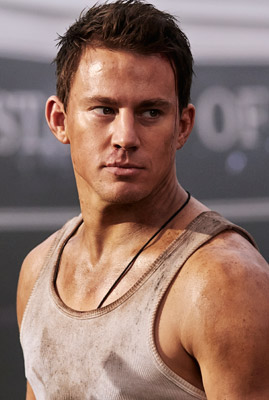 To train for the part, Jason Clarke went to the experts. 'There was a Special Forces guy that they brought in, and we did a lot of drills," he says. 'You are never going to get to the level of a real SEAL or Delta Force guy, but we worked as hard as we could."
To train for the part, Jason Clarke went to the experts. 'There was a Special Forces guy that they brought in, and we did a lot of drills," he says. 'You are never going to get to the level of a real SEAL or Delta Force guy, but we worked as hard as we could." Jason Clarke and Channing Tatum did not pull any punches in this man-to-man slugfest. 'They're big sequences," says Jason Clarke. 'One of the fight sequences is all in water and rain as the sprinkler system goes off. One is on the roof of the White House down to the green. It's the little things you don't think about at the time when they're blowing wind machines with dust and throwing debris at you – you want to bring a sense of something fresh and exciting to the fight sequence."
'Both the fights are messy," continues Jason Clarke. 'It's a good old-fashioned smackdown. We had to throw it down, and we threw it down."
About the Visual Effects
Roland Emmerich's longtime collaborators – Co-Producers and Visual Effects Supervisors Volker Engel and Marc Weigert – oversaw the visual effects on White House Down.
Where Volker Engel and Marc Weigert had previously been called upon to create UFOs blowing up the White House, or an earthquake destroying Los Angeles, their assignment was much more muted this time around. 'The whole movie takes place in and around the White House, and that's one of the few locations in the world where you are not allowed to shoot anywhere, not even nearby, and definitely not inside," explains Marc Weigert. 'So, the biggest challenge for us is to help create the location. Roland wants to keep this realistic. We're mimicking White House plans including several city blocks around it, replicating each tree, fence and guard house in the computer."
Marc Weigert and Volker Engel also played a valuable role in helping pre-visualise the sequences. 'We're able to show Roland Emmerich sequences and scenes and say, -What do you think about this?'" says Marc Weigert. 'Then, we work on it together and say, -Well, let's move the camera over a little bit. Let's have a longer lens here.' That way, we make the movie before we make the movie."
'The greatest achievement for us is when people come to us after having seen the film and they say, -I still have no idea which shots where visual effects and which shots where done for real. It just looks like you filmed the White House,'" says Volker Engel. 'Depicting a well-known landmark is always a challenge. Everyone in the whole world knows what the White House is supposed to look like. But after already destroying it for Roland Emmerich in Independence Day and 2012, we are slowly becoming White House experts."
About the Music
Producer Harald Kloser is also one of the film's composers, writing the score with his composing partner Thomas Wander. White House Down marks Harald Kloser's fourth score for a Roland Emmerich-directed picture. 'Thomas and I are like a well-oiled machine," he says. 'When we're starting on a project, it's exciting to me to figure out how we're going to create the mood with the music. It's like when you cook a meal – you choose the ingredients first, and then you decide what you're going to make. When you write a score, you can create a different mood by choosing, for example, a string quartet or a 150-piece orchestra and choir. So that's super-exciting for me. On White House Down, the score is metallic, it's electronic, it's modern, it's not old-fashioned, I hope. There's a lot of up-tempo music – maybe even in scenes where you wouldn't think of an up-tempo score."
White House Down
Release Date: September 5th, 2013
MORE
- Mission: Impossible Fallout
- Glenn Close The Wife
- Allison Chhorn Stanley's Mouth Interview
- Benicio Del Toro Sicario: Day of the Soldado
- Dame Judi Dench Tea With The Dames
- Sandra Bullock Ocean's 8
- Chris Pratt Jurassic World: Fallen Kingdom
- Claudia Sangiorgi Dalimore and Michelle Grace...
- Rachel McAdams Disobedience Interview
- Sebastián Lelio and Alessandro Nivola...
- Perri Cummings Trench Interview



